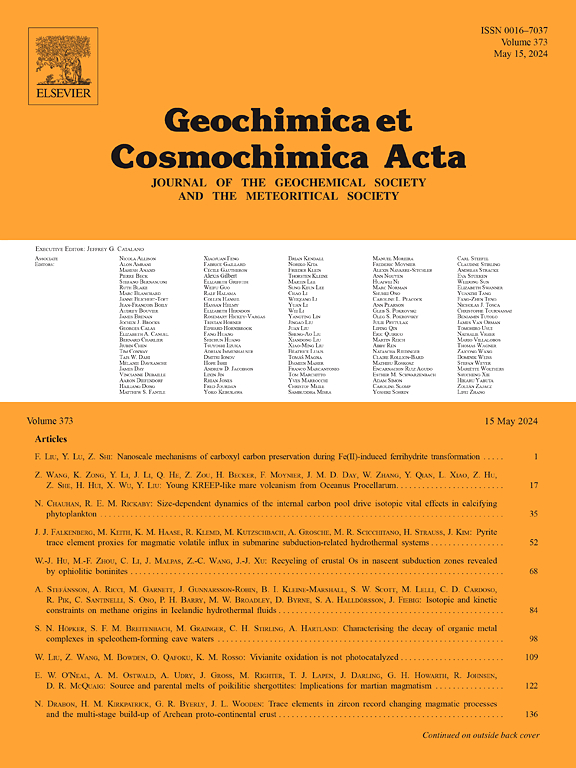Uranium isotope systematics of a low-productivity ferruginous ocean analog: Implications for the uranium isotope record of early Earth
IF 4.5
1区 地球科学
Q1 GEOCHEMISTRY & GEOPHYSICS
引用次数: 0
Abstract
The uranium isotope (δ238U) paleo-redox proxy has emerged as a premier tool for understanding ocean oxygenation through Earth’s history. The fidelity of this important proxy depends, however, on our mechanistic understanding of the pathways that induce uranium isotope fractionation during U(VI) reduction to U(IV). Uranium reduction has been extensively studied in euxinic (anoxic + sulfidic) environments, yet relatively few constraints currently exist on δ238U fractionation in ferruginous (anoxic + iron-rich) environments, even though ferruginous conditions may have been a dominant feature of Earth’s oceans for much of the geologic past. Here, we present a comprehensive uranium isotope study of modern, meromictic, oligotrophic to mesotrophic, ferruginous Canyon Lake, Upper Peninsula, Michigan (USA), including investigation of a high-resolution profile of lake waters, lake inlet and outlet waters, and groundwater, as well as shallow cores through both oxic and ferruginous sediments. The key observation of this study is that the entire water column, oxic sediments, and ferruginous sediments have indistinguishable δ238U values near the composition of the upper continental crust. This implies a lack of δ238U fractionation in the low-productivity, ferruginous environments of Canyon Lake. We suggest that uranium cycling in Canyon Lake is dominated by adsorption and co-precipitation with iron oxides, with only a limited role for U(VI) reduction. These processes result partly from aqueous uranium speciation in the lake, with the dominance of UO2-CO3 complexes in the upper water column leading to a high partition coefficient of uranium during sorption to iron oxides. In addition, the dominance of CaUO2(CO3)32– and Ca2UO2(CO3)3(aq) in bottom waters kinetically inhibits U(VI) reduction by Fe(II)(aq). The lack of U(VI) reduction and hence δ238U fractionation in Canyon Lake, despite Fe(II)(aq) concentrations >1.5 mM, is potentially analogous to the lack of δ238U fractionation that occurred in the Archean and Proterozoic oceans, as indicated by the carbonate δ238U record. In contrast with predictions that U(VI) should be rapidly reduced and scavenged from the water column in the presence of Fe(II)(aq), our data suggest a limited role for U(VI) reduction and δ238U fractionation under the low-nutrient, low-productivity, ferruginous conditions that characterized the oceans on the early Earth.
求助全文
约1分钟内获得全文
求助全文
来源期刊

Geochimica et Cosmochimica Acta
地学-地球化学与地球物理
CiteScore
9.60
自引率
14.00%
发文量
437
审稿时长
6 months
期刊介绍:
Geochimica et Cosmochimica Acta publishes research papers in a wide range of subjects in terrestrial geochemistry, meteoritics, and planetary geochemistry. The scope of the journal includes:
1). Physical chemistry of gases, aqueous solutions, glasses, and crystalline solids
2). Igneous and metamorphic petrology
3). Chemical processes in the atmosphere, hydrosphere, biosphere, and lithosphere of the Earth
4). Organic geochemistry
5). Isotope geochemistry
6). Meteoritics and meteorite impacts
7). Lunar science; and
8). Planetary geochemistry.
 求助内容:
求助内容: 应助结果提醒方式:
应助结果提醒方式:


